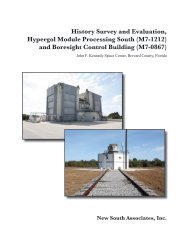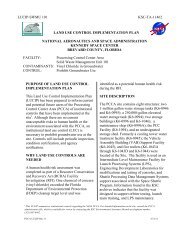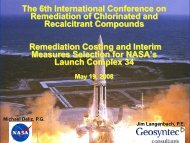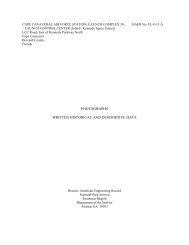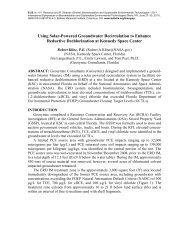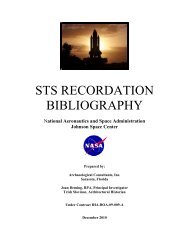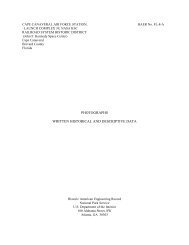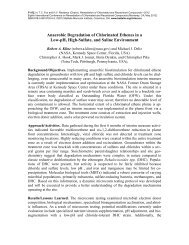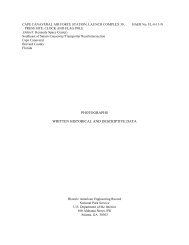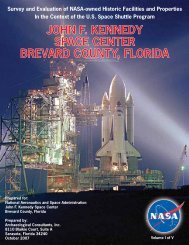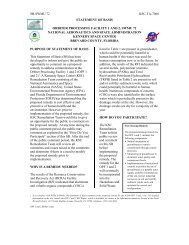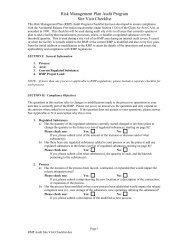Part II - Environmental Program at KSC - NASA
Part II - Environmental Program at KSC - NASA
Part II - Environmental Program at KSC - NASA
Create successful ePaper yourself
Turn your PDF publications into a flip-book with our unique Google optimized e-Paper software.
Space Shuttle <strong>Program</strong> Historic Properties 6-9<strong>NASA</strong>-wide Roll-up ReportThe d<strong>at</strong>a derived from these tests contributed directly to launch pad design concepts.Between 1974 and July 1976, 150 test firings were conducted <strong>at</strong> TF 116. Between Julyand November 1976, a second phase of testing was initi<strong>at</strong>ed using a 6.4-percent model ofthe launch pad <strong>at</strong> Vandenberg along with the same scale model of the Shuttle. A total of24 test firings were conducted, and these d<strong>at</strong>a were planned to be used in redesigning thelaunch pad <strong>at</strong> Vandenberg as an altern<strong>at</strong>e Space Shuttle launch site. During testsconducted in April 1979 as part of the acoustic test program, Tomahawk missile motorswere used to substitute for SRBs. A new series of tests for an upr<strong>at</strong>ed Space Shuttleconfigur<strong>at</strong>ion, conducted in December 1979, included strap-on rocket motors to augmentthe thrust of the SRBs. These tests fe<strong>at</strong>ured 6.4-percent scale models simul<strong>at</strong>ing thelaunch pads <strong>at</strong> the <strong>KSC</strong> and Vandenberg. In July 1981, firing tests <strong>at</strong>tempted to reproducethe stress loads detected on the Columbia during its April launch with a view towardsfinding a method for reducing those loads.In addition to components and systems testing during the ca. 1974-1981 developmentalphase of the SSP, the 32 month stand-down period following the Challenger accident ofJanuary 1986 was a time of significant testing activities and advancements. In accordancewith the Rogers Commission recommend<strong>at</strong>ions, one focus of the Return to Flight workwas the redesign and recertific<strong>at</strong>ion of a Redesigned Solid Rocket Motor (RSRM). Inresponse, MSFC engineers performed tests for the SRB joint and seal to evalu<strong>at</strong>e designchanges under all relevant environmental and loading conditions. During the post-Challenger period, other test programs <strong>at</strong> MSFC included the full scale testing of theSSME, plus tests of the thermal protection system for the SRB and ET, SRM O-rings,and SSME injectors, bearings and seals. In the 1990s, the Advanced Engine Test Facility(Building 4670) played a key role in the full-scale testing of advanced technologies forthe SSME. Also <strong>at</strong> this time, Building 4670 was used to test other hardware, including theSpace Shuttle liquid hydrogen pressure valve. The Control Facility, or “blockhouse,”(Building 4674), controlled the testing <strong>at</strong> Building 4760, including important tests for theSSME (1986-1990s).6.2.2 Research and Development (R&D)Several historic properties <strong>at</strong> both the JSC and the MSFC exemplify <strong>NASA</strong>’s R&Daccomplishments in support of the SSP. These include four facilities <strong>at</strong> the JSC whichhave supported the SSP since the 1970s: the Crew Systems Labor<strong>at</strong>ory (Building 7), theAvionics System Labor<strong>at</strong>ory (Building 16), the Communic<strong>at</strong>ions and TrackingDevelopment Labor<strong>at</strong>ory (Building 44) and the ARMSEF (Building 222). First used inthe early developmental phase of the program, these facilities contain unique equipment,such as simul<strong>at</strong>ors and thermal vacuum chambers, which continue to provideperformance testing of primary life support system equipment, Space Shuttle avionicssystems, and spacecraft flight-equivalent communic<strong>at</strong>ions systems and their interfaces.Equipment vital to the success of all Shuttle missions, including spacesuits andbackpacks, as well as software and spaceflight hardware, are performance tested,valid<strong>at</strong>ed, and certified in these facilities.July 2008Archaeological Consultants, Inc.



